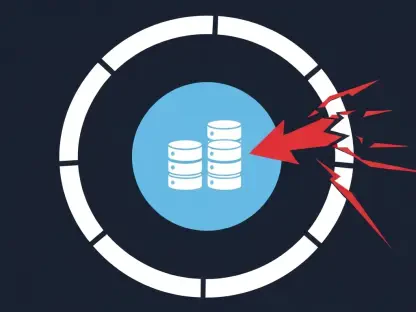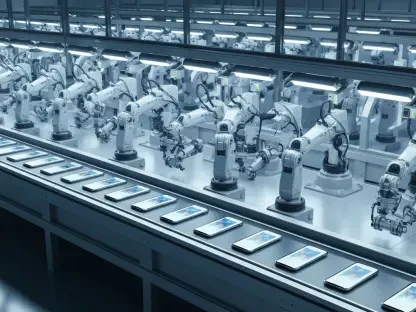In an era where artificial intelligence drives unprecedented growth across industries, a staggering challenge looms over the market: the inefficiency of current hardware in handling AI inference workloads. As data centers grapple with skyrocketing energy costs and memory bottlenecks, the need for scalable, cost-effective solutions has never been more critical. Enter D-Matrix, a company carving a niche by targeting AI inference rather than the training phase, with hardware designs that could disrupt reliance on high-bandwidth memory (HBM). This analysis explores the market dynamics surrounding AI hardware, evaluates D-Matrix’s innovative approaches, and projects potential shifts in the industry landscape, offering strategic insights for stakeholders navigating this evolving space.
Market Trends and Challenges in AI Hardware
The Persistent Memory Wall Barrier
The AI hardware market faces a formidable obstacle known as the “memory wall,” where data transfer bottlenecks between compute units and memory components severely hamper performance. This issue, particularly acute in inference tasks—deploying trained models for real-time predictions—results in significant delays and power inefficiencies. While HBM has been a go-to solution for training workloads, its high costs and limited supply create barriers, especially for smaller data centers. Industry data suggests that memory-related constraints account for a substantial portion of operational expenses in AI deployments, underscoring an urgent demand for alternative technologies.
Rising Demand for Inference Solutions
As large language models (LLMs) and other AI applications proliferate, the spotlight on inference hardware intensifies. Unlike training, which occurs sporadically, inference runs continuously in real-world scenarios, amplifying energy and latency concerns. Market reports indicate that inference workloads now constitute a growing share of data center operations, yet innovation in this area lags behind. The disparity between HBM’s dominance and the accessibility needs of diverse market players fuels a gap that emerging companies are eager to bridge, setting the stage for disruptive entrants with novel architectures.
Supply Chain and Cost Pressures
Compounding these technical challenges are supply chain constraints surrounding HBM, which disproportionately impact mid-tier and smaller operators unable to secure premium memory modules. Cost volatility in the semiconductor space further exacerbates the issue, with HBM pricing often out of reach for budget-conscious entities. This uneven landscape highlights a critical market need for cost-effective, scalable alternatives that can democratize access to high-performance AI hardware, a niche where innovation could yield significant competitive advantages.
D-Matrix’s Strategic Position in the Market
Corsair Design: A Chiplet-Based Disruption
At the forefront of D-Matrix’s offerings is the Corsair design, a chiplet-based architecture integrating 256GB of LPDDR5 and 2GB of SRAM. This approach aims to bypass HBM dependency by co-packaging acceleration engines with DRAM, slashing latency and power consumption. Initial projections suggest Corsair could reduce operational costs for inference tasks, though scalability in real-world data center environments remains untested. Challenges such as heat dissipation and manufacturing expenses pose risks, yet if successful, this design could carve a unique position in a market hungry for efficiency.
Pavehawk Technology: A Bold Efficiency Claim
Building on Corsair, D-Matrix is advancing Pavehawk, a technology leveraging TSMC’s N5 logic die with 3D-stacked DRAM. The company asserts a potential 10x improvement in bandwidth and energy efficiency over HBM4 for inference workloads, a claim that could redefine market standards. By stacking multiple DRAM dies over logic silicon, Pavehawk seeks to maximize capacity while minimizing data movement costs. However, similar stacked-memory concepts have historically faced yield issues and cost overruns, casting doubt on near-term viability. Market adoption will hinge on rigorous validation over the coming years.
Competitive Landscape and Differentiation
D-Matrix operates in a crowded field where memory-compute integration is gaining traction, with competitors exploring solutions like built-in controllers and interconnect standards such as CXL. What sets D-Matrix apart is its focus on custom silicon optimized for cost, power, and performance balance, targeting underserved segments of the market. Analysts note that while HBM remains entrenched due to widespread adoption, supply disparities create openings for niche players. The company’s success will depend on overcoming industry inertia and proving the reliability of its unproven hardware in high-stakes environments.
Future Projections for AI Inference Hardware
Shifting Away from HBM Dominance
Looking ahead, the AI hardware market appears poised for a potential pivot away from HBM-centric designs, driven by innovations like those from D-Matrix. Economic factors, including HBM cost fluctuations, coupled with technological advancements in 3D stacking, are expected to accelerate this shift between 2025 and 2027. Forecasts suggest that if alternative architectures demonstrate consistent performance, adoption rates for custom inference solutions could rise significantly, particularly among energy-conscious data centers managing LLM workloads.
Broader Industry Implications
The evolution of inference hardware is likely to inspire a wave of tailored solutions, as market players seek to address the unique demands of AI deployment at scale. Trends point toward increased investment in memory-compute integration, with smaller data centers potentially benefiting most from reduced reliance on scarce resources. However, geopolitical tensions in semiconductor supply chains and regulatory hurdles around manufacturing could slow progress, creating uncertainty in long-term projections. Stakeholders must remain agile to navigate these complexities.
Energy Efficiency as a Market Driver
A key growth driver in this space is the pressing need for energy-efficient solutions, as data centers face mounting pressure to curb consumption amid global sustainability goals. Innovations that tackle power-hungry AI workloads without sacrificing performance are projected to gain traction. Companies like D-Matrix, if able to deliver on efficiency promises, could influence market standards, pushing competitors to prioritize similar advancements. This focus on sustainability may redefine purchasing decisions over the next few years.
Reflecting on Market Insights
Looking back, this analysis delved into the critical challenges and opportunities within the AI hardware market, spotlighting D-Matrix’s potential to disrupt the inference landscape with designs like Corsair and Pavehawk. For industry stakeholders, the key takeaway is the growing necessity for alternatives to HBM, driven by cost, supply, and efficiency concerns. Moving forward, data center operators and IT leaders should consider strategic partnerships or pilot programs with emerging hardware providers to test scalability and performance. Monitoring D-Matrix’s progress, particularly in real-world validations, emerges as a prudent step to stay ahead of market curves. Ultimately, investing in innovative inference technologies offers a pathway to mitigate operational burdens and secure a competitive edge in an increasingly AI-driven world.









